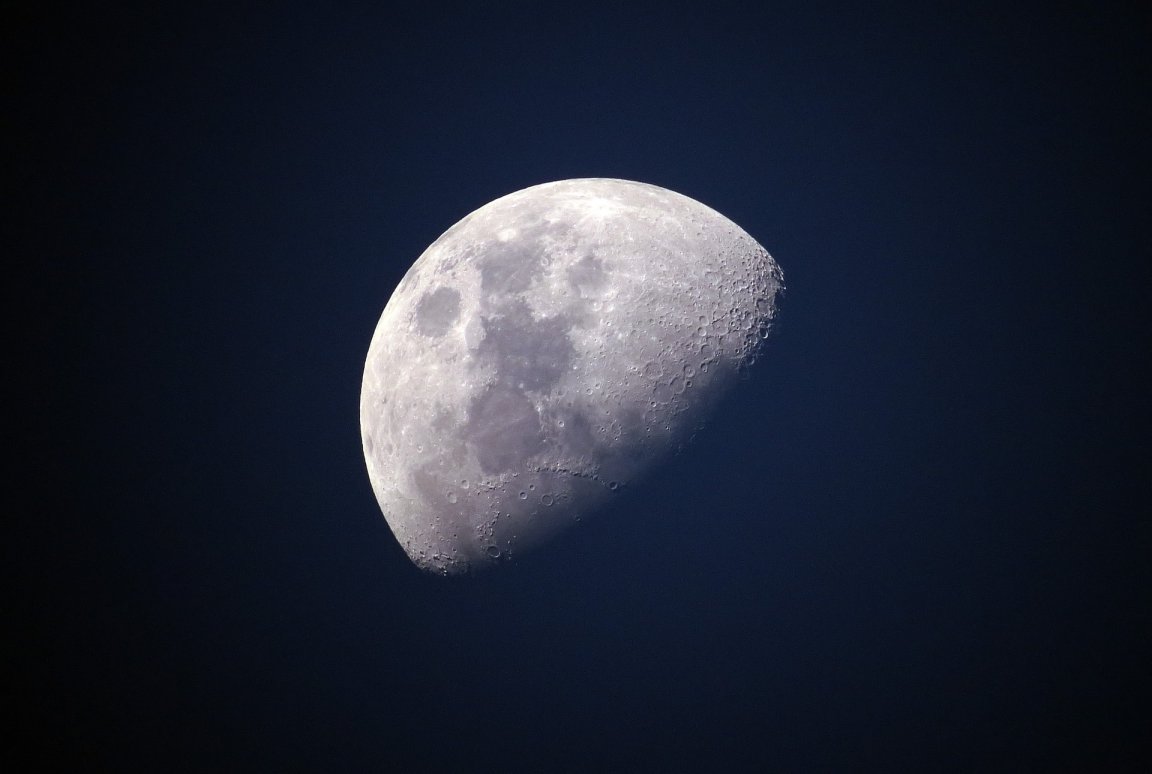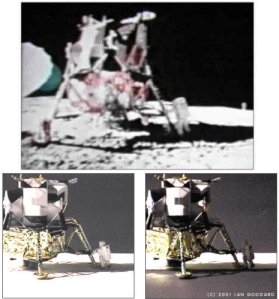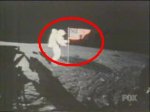
A Lunar Hoax?
Between 1969 and 1972, the Apollo program flew six successful missions, putting humanity on the Moon in one of the greatest moments in American (and quite possibly world) history.
Or so the story goes.
Did NASA and the United States stage the Moon landing? Is there any way to prove, beyond a reasonable doubt, that man went to the Moon? Or was the “Moon Landing” really just the greatest hoax of all time? Let’s take a moment to flesh out this little controversy and try to separate fact from fiction.
Specifically, we will be delving into the “documentary” called “Moon Landing Hoax,” which was aired by the Fox network in 2001 (you can watch it on that website). But before we really begin, for the record, I cannot possibly cover every claim out there. So for the sake of brevity, I will only cover the most well known claims. For further reading, please see the websites that are linked below.
Let us begin:

Claim #1: The Pictures are Backlit
Argument: The sun is the only source of light, so the shadows should be completely dark. You can clearly see objects in the shadow; this requires additional light.
Well, that is almost right. Yes, being able to see objects in shadows requires additional light, but the Sun isn’t the only light source on the moon. The lunar surface provides this backlight by reflecting the sunlight that hits it (ever tried to stare at a sandy beach on a blistering sunny day? Or even worse, the snow? It’s kind of the same thing as that).
Ian Goddard set up a series of experiments to test this backlighting effect. In the top image, we see the iconic photograph of an Apollo astronaut descending the ladder onto the lunar surface. Of course, he is dramatically lit so the television audiences can see him preparing to take the first human steps on the moon.
Below it, we see the experiments. The picture on the left uses a more reflective surface (simply plain, white paper). The astronaut is, as you can see, lit. And the shadows, of course, remain in place. The picture on the right, however, has black paper concealing the surface, which prevents light from reflecting off the ground and lighting the astronaut’s suit.
Claim #2: Where Are All the Stars?
Argument: You cannot see the stars in pictures taken by Apollo astronauts. Without air, the stars should be more visible.
If the astronauts had cameras on tripods set to have long exposure times, the stars would become visible. Instead, the cameras were set up to take pictures of the bright astronauts with the bright Sun and the bright lunar surface. This means the shutter time was much faster and the stars didn’t have time to get exposed on the camera.

See more
As a proof of concept, this image was taken by an astronaut leaving the International Space Station on a Russian Soyuz spacecraft. It shows the Space Shuttle Endeavour docked to the ISS during its final mission on May 23, 2011. This image is special in the sense that it’s one of the first images ever taken of a shuttle docked to the ISS. It too was taken with a low exposure rate making the background stars appear invisible.

In contrast, a host of astrophotographers take images known as “nightscapes.” These images are able to reveal brilliant color and texture of the sky that you can’t get with the unaided eye (because the long exposure allows the camera to record more than a fraction of a second’s worth of data). Consider someone attempting to take an image of the stars with a disposable camera. Their attempts would be less than successful. If you want stars, you need to have a long exposure time. That’s precisely why Hubble took so long to capture the Ultra Deep Field Image.
Claim #3: Stage Lighting
Argument: The shadows in the Moon pictures are cast in different directions. This means there must be at least two light sources.
First, anyone who has ever walked outside at night under street lamps will notice multiple shadows cast from various street lamps. As a good rule of thumb, one light source equals one shadow. If there were multiple spotlights in use, we should see more than one shadow for each object, but that is not the argument made by Moon-hoaxers. They are talking about the directions of the shadows (just to be clear). Now, if you look at the pictures, you will see one shadow. The reason the shadows appear in different directions is an effect caused by the uneven lunar surface and the 2-dimensional nature of photographs.
Again, a mock-up of the lunar landing site was previously set up to see if there was any merit to this claim. The picture is surprisingly accurate, but almost does a better job at dispelling this argument. It so happens that the three cast shadows all point in different directions from one another in the recreation, whereas there are only two directions seen in the Apollo picture. All created with a single light source.
Claim #4: No Blast Crater
Argument: There is no blast crater under the Lunar Module. The Lunar Module should have created a blast crater as it landed.
When landing, the Lunar Module only exerted a pressure of about 1.5 pounds per square inch (that isn’t a lot).
Claim #5: The Dust Paradox
Argument: The Lunar Module should have kicked up dust as it landed. That dust should be visible on the feet of the Module.
Again, the Module did kick up a little dust, but not anywhere near that much. Why? Simply because there is no air on the moon. When a rocket blasts off from Earth, air pressure helps kick everything around. On the Moon, however, only dust that touched the exhaust was displaced.
Claim #6: Flag Ripples

Argument: As the flag is deployed, it waves due to a rogue breeze. There is no breeze on the moon, so this must have been filmed on Earth.
First, it depends on how you want to define “wave.” If a “wave” is defined as the astronauts planting the flag (which is held in place by both a horizontal and vertical bar), twisting the poll to get the flag to stand upright, etc., then yes, the flag waved; however, it wasn’t due to a breeze. The reason the flag has ripples in it is because the horizontal bar didn’t fully extend on the Apollo 11 landing. NASA thought it looked cool and designed the other flagpoles to follow suit.
Claim #7: The Poisoned Belt
Argument: The Van Allen Belts (the radiation belts above Earth) would kill any astronaut passing through it.
I think Phil Plait, over at Bad Astronomy, puts it best: “The van Allen belts are regions above the Earth’s surface where the Earth’s magnetic field has trapped particles of the solar wind. An unprotected man would, indeed, get a lethal dose of radiation, if he stayed there long enough. Actually, the spaceship traveled through the belts pretty quickly, getting past them in an hour or so. There simply wasn’t enough time to get a lethal dose, and, as a matter of fact, the metal hull of the spaceship did indeed block most of the radiation.”
Claim #8: Bogus Moon Rocks
Argument: The “Moon rocks” were meteorites from Antarctica or were manufactured in a lab.

As for the manufactured approach, we have Moon rocks from Antarctica that fell as meteorites. The samples from the Moon were tested against the samples from Antarctica, and the tests proved they are from the Moon. As for the claim that all of the Moon rocks came from Antarctica, that’s also incorrect. As any meteorite falls through the atmosphere, it gets scorched and oxidized. The Apollo samples do not possess those same qualities.
Bonus Proof:
It’s important to remember the politics surrounding the Moon landing. While the Apollo astronauts were talking to NASA, the Russians, radio astronomers, and ham radio operators from around the world were tuning in. Third party observatories, such as the Alfred Lovell, were able to confirm the authenticity of the Moon landing. If the USA had faked the landings, the Russians would have been the first to call them on the bluff.
In the end, many of the claims come from people simply not understanding the principles of photography or physics. That’s okay. But remember: there is a difference between a skeptic and a denier. A skeptic demands evidence, and accepts it when it is given. Deniers blindly stick to their own beliefs without any evidence and refuse to accept valid evidence when it is presented to them.
I will conclude this article with a quote from Stephen Hawking, which sums up the whole mystery quite nicely (even though Hawking was talking about aliens, the same principle applies): “If the government is covering up knowledge of aliens, they are doing a better job of it than they do at anything else.”
TL;DR – The moon landing was real.